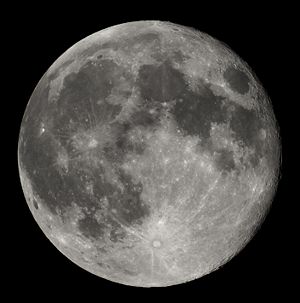Moon
The second brightest object in the sky, after the sun, is the Moon. It is the only natural satellite in orbit around the Earth at a distance of 384,400 km. With a diameter of 3476 km and mass of 7.35e22 kg, the moon is larger than any other satellite orbiting the other planets of the solar system. The Romans called the moon, Luna and the adjective lunar is still used to describe things related to the moon.
The brightness of the moon is from sun light reflected off it's surface. As the moon orbits the Earth, different amounts of illumination of the moon's surface are visible. This makes it appear like the moon is changing shape throughout the month. When the moon is almost directly between the earth and the sun, little or no illuminated lunar surface is visible. This is known as a new moon. As the moon moves round, an arc of illuminated surface becomes visible known as a crescent moon. This is known as waxing crescent. The width of the crescent gradually increases until when the moon is a quarter of the way round it's orbit, a full semi-circle is visible. This gradually gets rounder. This is known as waxing gibbous. When the sun and the moon are on opposite sides of the earth, the moon appears as a complete circle. This is called the Full Moon. It is at this time that the light from the moon, reaching earth, is at its greatest. The moon continues on its orbit, gradually narrowing to a half moon. This time before the half moon known as waning gibbous. The moon continues its phase though waning crescent moon before completing the cycle of phases becoming a new moon again.
Man has often dreamed of traveling to the moon. During the 20th century, that dream became a reality. The Soviet Union was the first nation to send a space craft to the moon. Luna 2 impacted the Moon's surface in 1959. The first photographs of the far side of the moon were taken by Luna 3, another Soviet craft, later that same year. The American Apollo program saw a series of manned missions to the moon. The fist men, Neil Armstrong and Buzz Aldrin, landed on the moon on July 20, 1969 as part of Apollo 11. Several other manned Apollo missions followed with the last, Apollo 17, reaching the moon on December 11, 1972. In total, 12 men have walked on the moon.
The moons gravitational pull has a strong visible effect on Earth. The oceans of the Earth, and the planet itself, are stretched up towards the moon as they rotate underneath. This causes the twice daily tides in the sea and oceans. The gravitational pull between the moon and the earth also causes a slight deceleration in the Earth's spin. The Earth's rotation is slowing by about 1.5 milliseconds a century and in balance, the moon's orbit is widening by 3.8 centimeters each year. A similar slowing of rotation would have occurred on the moon in the past but now the moons rotation has slowed such that it is closely synchronized to the period of it's orbit.
